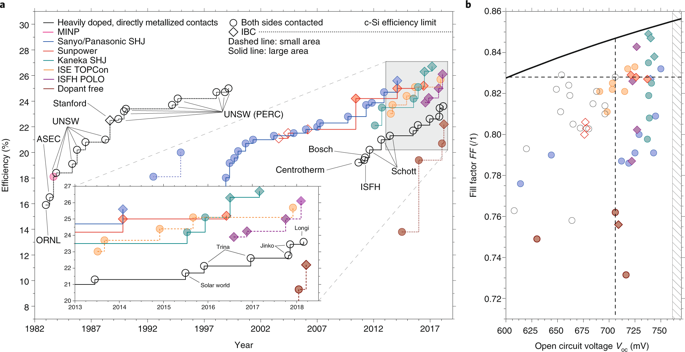Nature Energy ( IF 49.7 ) Pub Date : 2019-09-16 , DOI: 10.1038/s41560-019-0463-6 Thomas G. Allen , James Bullock , Xinbo Yang , Ali Javey , Stefaan De Wolf

|
The global photovoltaic (PV) market is dominated by crystalline silicon (c-Si) based technologies with heavily doped, directly metallized contacts. Recombination of photo-generated electrons and holes at the contact regions is increasingly constraining the power conversion efficiencies of these devices as other performance-limiting energy losses are overcome. To move forward, c-Si PV technologies must implement alternative contacting approaches. Passivating contacts, which incorporate thin films within the contact structure that simultaneously supress recombination and promote charge-carrier selectivity, are a promising next step for the mainstream c-Si PV industry. In this work, we review the fundamental physical processes governing contact formation in c-Si. In doing so we identify the role passivating contacts play in increasing c-Si solar cell efficiencies beyond the limitations imposed by heavy doping and direct metallization. Strategies towards the implementation of passivating contacts in industrial environments are discussed.
中文翻译:

晶体硅太阳能电池的钝化触点
全球光伏(PV)市场以具有重掺杂,直接金属化触点的基于晶体硅(c-Si)的技术为主导。随着克服了其他限制性能的能量损耗,光生电子和空穴在接触区域的复合越来越多地限制了这些器件的功率转换效率。为了前进,c-Si PV技术必须实现替代的接触方法。对于主流的c-Si PV产业而言,钝化触点将薄膜结合在触点结构中,同时抑制了重组并提高了电荷载流子的选择性,这是一个有希望的下一步。在这项工作中,我们回顾了控制c-Si中接触形成的基本物理过程。在此过程中,我们确定了钝化接触在提高c-Si太阳能电池效率方面所发挥的作用,超出了重掺杂和直接金属化所施加的限制。讨论了在工业环境中实施钝化接触的策略。











































 京公网安备 11010802027423号
京公网安备 11010802027423号